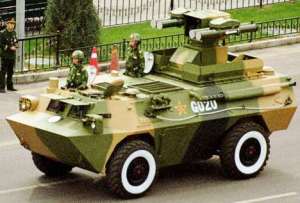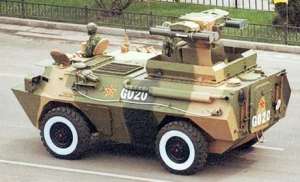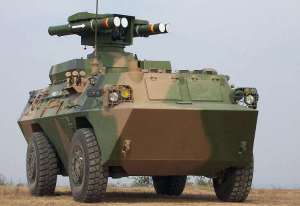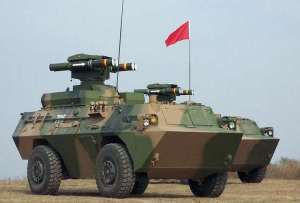| Designation: | Type 92B |
 |
|---|---|---|
| Manufacturer: | NORINCO - China North Industries Group Corporation - CNGC | |
| Product type: | Armoured Vehicles | |
| Name: | Self-propelled antitank guided missile system |
In 2000, NORINCO (China North Industries Corporation) finally released details of their new Red Arrow 9 (Hong Jian 9) anti-tank guided missile (ATGM) system which made its first public appearance during a major parade held in Beijing late in 1999.
The name Red Arrow 9 is for export purposes only, within the People's Liberation Army (PLA) it is referred to as the SD-1 Lightning and it is understood that it first entered service in 1992.
The first application for the Red Arrow 9 ATGM is self-propelled, installed on a modified version of the NORINCO WZ 551 (6 × 6) armoured personnel carrier, but in a 4 × 4 configuration.
This 4 × 4 chassis is also used as the basis for the older Red Arrow 8 ATGM system that has been in service with the PLA for some years.
It is believed that the chassis for the latest Red Arrow 9 application is designated Type 92B with the industrial number being WXLZ602B.
It is understood that the PLA designation for this system is the Type 92B HJ-9 ATGM carrier. The earlier model, armed with the shorter range Red Arrow 8, is understood to have the PLA designation of the Type WZ91 HJ-8.
It is considered that production of this system is complete but production could commence again if additional orders are placed.
The hull of the Type 92B 4 × 4 vehicle is of all-welded steel armour construction which provides the occupants with protection from small arms fire and shell splinters.
The driver is seated at the front on the left side and has a single-piece hatch cover above his position that opens to the left. To his front are three periscopes, the centre one of which can be replaced by a passive periscope for driving at night. There is another seat at the front right with a single-piece hatch cover that opens to the rear. It is believed that this seat is occupied by the vehicle commander.
There is an additional roof hatch on the right side of the hull just in front of the launcher. This has a single-piece hatch cover that opens to the rear and in front of this is a single rotatable day periscope.
To the immediate front of both of these positions is a bulletproof windscreen with a hinged shutter above, which can be rapidly lowered to cover this windscreen. Forward vision is then obtained via roof-mounted periscopes. In addition to these day periscopes there is a circular roof-mounted periscope at the front-right side of the hull, which may be used for target-acquisition purposes. To the front are periscopes.
The power pack is to the immediate rear of the driver's position with the air intake and outlet louvres being located in the roof. The exhaust pipe runs along the left side of the upper part of the hull to the rear. In the rear of the hull is a single door that opens to the right with an integrated firing port. This door is used for crew entry and missile-supply purposes. There are additional small firing ports in either side of the hull.
There is a door in the lower part of the hull on either side between the front and rear road wheels. Another person is seated on the right side of the hull, alongside the power pack compartment.
Mounted at the rear is the Red Arrow 9 missile installation with the day/night sighting system in the centre and two missiles in the ready to launch position either side.
The Red Arrow 9 ATGM is of a different design to the older Red Arrow 8 and apart from its warhead, is very similar in appearance to the US Raytheon Systems Company 3,750 m range TOW ATGM, which is the most widely deployed missile of its type in the world.
In some respects Red Arrow 9 is also similar to the Israel Military Industries MAPATS ATGM system, which was first revealed in 1984.
The launcher can be power traversed 200° left and right with powered elevation and depression being 10°. In addition to the four Red Arrow 9 missiles in the ready to launch position another eight rounds are carried in the hull. These can be loaded onto the retracted launcher automatically or manually.
The gunner is seated under full armour and NBC protection. The method of guidance is Semi-Automatic Command-to-Line Of Sight (SACLOS) and all the operator has to do to accomplish a hit on the target, is to keep his optical sight on the target.
In addition to the standard two field of view day sighting system, a thermal sight is also fitted to enable targets to be engaged under conditions of smoke and fog. This operates in the 8 to 12 um range and can detect a target at a range of 4,000 m and recognise a target at a range of 2,500 m.
The major difference between Red Arrow 9 and the US Raytheon TOW is that the former is laser guided, while TOW is wire guided. The laser has a range of more than 5.5 km and operates in the 0.9 um waveband.
The standard production TOW ATGW has a maximum range of 3,750 m.
The Red Arrow 9 missile is ejected out of its launcher after which the main motor cuts in. The missile is 152 mm in diameter and with its associated launch tube weighs 37 kg.
It has four fins at the rear that unfold after launch with the four control surfaces almost two thirds down the missile towards the rear. Maximum rate of fire is quoted as two missiles per minute when engaging targets at maximum range.
The missile has a minimum range of 100 m and a maximum range of 5,000 m. The main first-generation HEAT (High Explosive Anti-Tank) warhead will penetrate 320 mm of rolled homogenous armour at an angle of 68° protected by Explosive Reactive Armour (ERA). The nose-mounted HEAT precursor charge activates the ERA, allowing the main charge to penetrate the armour.
There are at least two versions of Red Arrow 9, the Red Arrow 9A millimetre wave command guidance version and the Red Arrow 9B laser beam riding version.
Some sources have stated that there are three versions of the Red Arrow 9 marketed, the SACLOS, millimetre wave command guidance and laser.
Although the first known application of the Red Arrow 9 is the WZ 551 (4 × 4) wheeled armoured vehicle, it can also be installed on a number of other platforms, including full-tracked armoured vehicles, trucks, helicopters and coastal craft.
Mounted either side of the hull firing forwards is a bank of four electrically operated smoke grenade launchers.
No detailed specifications of the chassis/platform have been revealed, although it is estimated to have a combat weight of about 13.75 tonnes and powered by a Deutz air-cooled diesel Model BF8L41. This gives the system a maximum road speed of 95 km/h and an operational road range of up to 800 km. The vehicle has an NBC system but is not amphibious.
In 2002, it was revealed that NORINCO had developed a much lighter version of the system called Red Arrow 9A, which can be installed on a variety of light tracked and wheeled vehicles, armoured and unarmoured.
When mounted on a light vehicle, for example the widely deployed US AM General HMMWV (4 × 4), the complete system (for example platform, launcher and missiles) weighs 2,800 kg. The launcher is said to weigh 150 kg with a total of six missiles being carried, three either side.
The launcher can be traversed through 360° with elevation from -10 to +10° having a stated firing rate of two missiles a minute with the crew of two. Maximum range is quoted as 5,500 m with a 90 per cent plus hit probability.
The tandem HEAT warhead of the Red Arrow 9 will penetrate 320 mm of steel armour at an incidence of 68° protected by Explosive Reactive Armour (ERA).
|
||||||||||||
 |
 |
 |
 |
 |
